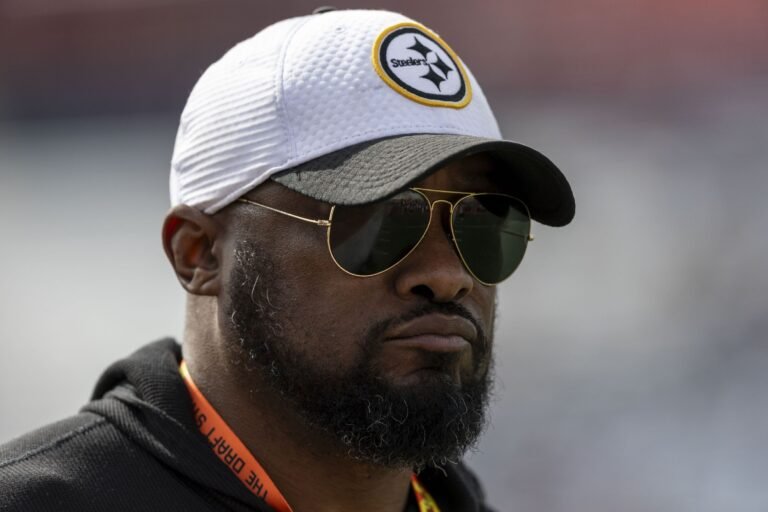The signing itself felt surreal. Rodgers, released by the Jets after the cruel Achilles tear that wrecked his 2023 debut season, flirted with retirement and weighed a half‑dozen suitors before inking a one‑year, $13 million deal in Pittsburgh last night. He framed the choice as “a soul decision, not an ego decision,” a line that splashed across social media timelines in seconds. National analysts immediately hailed the move as “a steal,” praising his still‑elite arm strength and pre‑snap wizardry while conceding the obvious: mobility is nowhere near vintage form.
Privately, Steelers officials believe Rodgers’ mental processing and accuracy can mask age‑related decline. The front office also loves the hidden upside—they avoided mortgaging future draft capital and kept 2026 cap flexibility intact should this all go south by Thanksgiving.
Here’s the raw, uncomfortable truth: Tomlin’s record‑setting streak of 18 consecutive non‑losing seasons remains astonishing, but Pittsburgh’s last postseason win came in the 2016 divisional round. The ensuing drought (wild‑card exits in 2017, 2020 and 2024, plus back‑to‑back January weekends at home) has frayed the patience of a fanbase raised on rings. Analytics site PFF notes that management’s willingness to bring in Rodgers is an explicit signal that “the contention window is 2025—nothing less.
A Super‑Bowl‑or‑bust narrative has always hovered around the Steelers, yet this year it carries a sharper edge. How many more hall‑of‑fame talents must the franchise import before critics conclude the constant variable is the headset, not the huddle?
-
Scheme chemistry: Rodgers long admired OC Arthur Smith’s wide‑zone framework in Tennessee; he believes the play‑action, boot‑leg spine of that offense can extend his shelf life. Smith, meanwhile, gets a quarterback who can re‑set protections without burning timeouts.
-
Weapons check: George Pickens (fresh off a 1,300‑yard breakout) becomes Rodgers’ new Davante Adams. Pat Freiermuth offers the seam‑stretching security blanket missing in New York. Najee Harris and Jaylen Warren form a thunder‑and‑lightning backfield, perfect for Rodgers’ beloved RPO tags.
-
The lone flashing caution light. Two rookies are penciled in at left tackle and center. Rodgers was sacked on his fourth snap as a Jet—Steelers brass cannot allow déjà vu.
Yet local beat writers warn that the honeymoon could sour quickly if chemistry lags. One SI insider flat‑out frets that Rodgers’ famous stubbornness might clash with Tomlin’s “standard is the standard” mantra.
At midnight, downtown bars erupted in chants of “Rod‑ge‑ers! Rod‑ge‑ers!” By dawn, talk‑radio switchboards were jammed with callers questioning whether a 41‑year‑old quarterback on a rebuilt Achilles is anything more than a headline grab.
The optimists picture Rodgers reviving the long ball, forcing safeties back, and giving T.J. Watt a fourth‑quarter lead to protect for the first time in years.
The skeptics remember Ben Roethlisberger’s creaky final campaign and fear Rodgers could hit the same wall—only faster—while delaying a real youth movement at the position.
Former Packers linebacker Brady Poppinga, never one to mince words, predicted Rodgers “could have a long season in Pittsburgh” if the line falters, puncturing some of that giddy optimism before OTAs even begin.
Tomlin has survived coordinator overhauls, quarterback transitions, even Antonio Brown’s implosion. This time, though, the escape routes are few:
Keyshawn Johnson already framed the discussion bluntly: Rodgers will only consider a second Steelers season “if 2025 proves this marriage can win the biggest games.” The implication? Fail once, and both quarterback and coach might vanish in the same offseason.
Pittsburgh opens with the Chiefs on Kickoff Thursday, travels to Baltimore in Week 3, and draws the Bengals twice after Thanksgiving. Rodgers thrives on marquee stages; Tomlin’s teams often rise as underdogs. Yet statistics reveal Pittsburgh hasn’t beaten a playoff team on the road since 2021. That storyline either ends this fall or becomes the epitaph.
Rodgers’ quick‑rhythm mastery lifts Pittsburgh to 12 wins, the defense feasts on forced errors, and Tomlin finally breaks the playoff drought, vindicating the franchise’s loyalty and Rodgers’ belief that his story still has one heroic chapter left.
The line can’t protect, Rodgers’ mobility betrays him, and another wild‑card exit triggers the most uncomfortable coaching conversation the Rooney family has held since 2006.
Aaron Rodgers didn’t sign to finish his career as an asterisk. Mike Tomlin didn’t survive 18 straight non‑losing seasons to watch someone else pilot “his” roster to the mountaintop. Their destinies are now welded together—a one‑year experiment that could end in confetti or in catastrophe.


